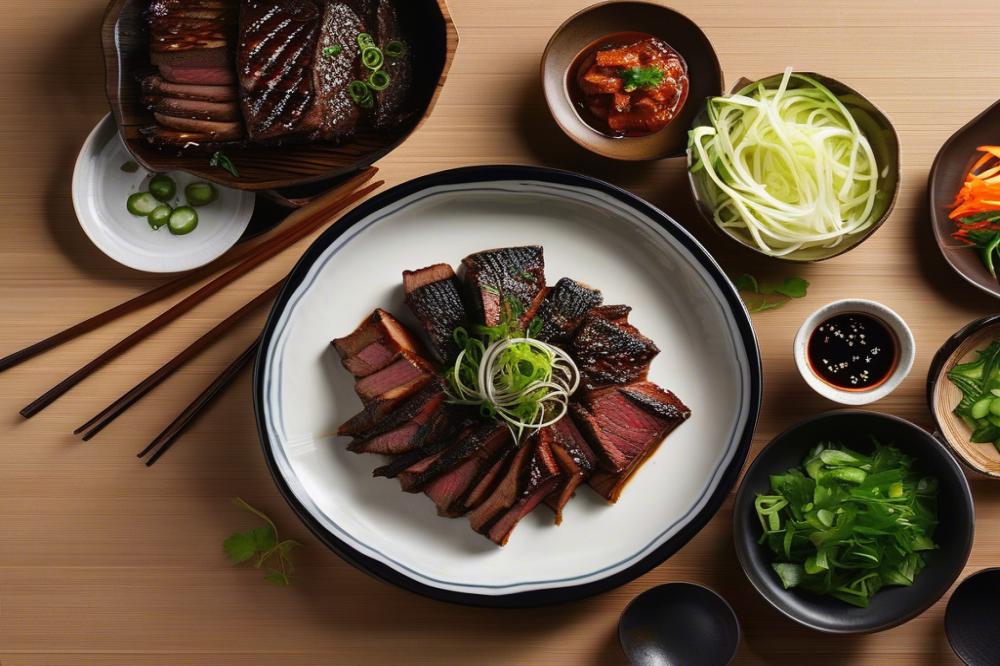Introduction
Yangnyeom Galbi is a beloved dish in Korean cuisine, showcasing the rich flavors that define this culture’s cooking. At its core, this dish consists of marinated beef ribs that bring together a delightful blend of taste and texture. The secret to making such a delicious meal lies in using traditional recipes. Authentic flavor is vital and can be easily lost if shortcuts are taken.
Grilled meat holds a significant place in Korea’s culinary traditions. Families gather around tables filled with sizzling plates of various meats, often enjoying the process as much as the meal itself. Ingredients like garlic, sesame oil, and soy sauce come together to create the sweet and savory marinade that makes each bite irresistible. Cooking techniques vary, but a true Korean BBQ experience emphasizes the joy of grilling meats right at the table.
Understanding the background of Yangnyeom Galbi adds to the overall appreciation of the dish. Many recipes have been passed down through generations, ensuring the culture’s flavors are preserved. These thoughtful preparations and authentic ingredients work together harmoniously, transforming simple beef ribs into a dish that delights palates.
Yangnyeom Galbi: The Essence of Korean BBQ
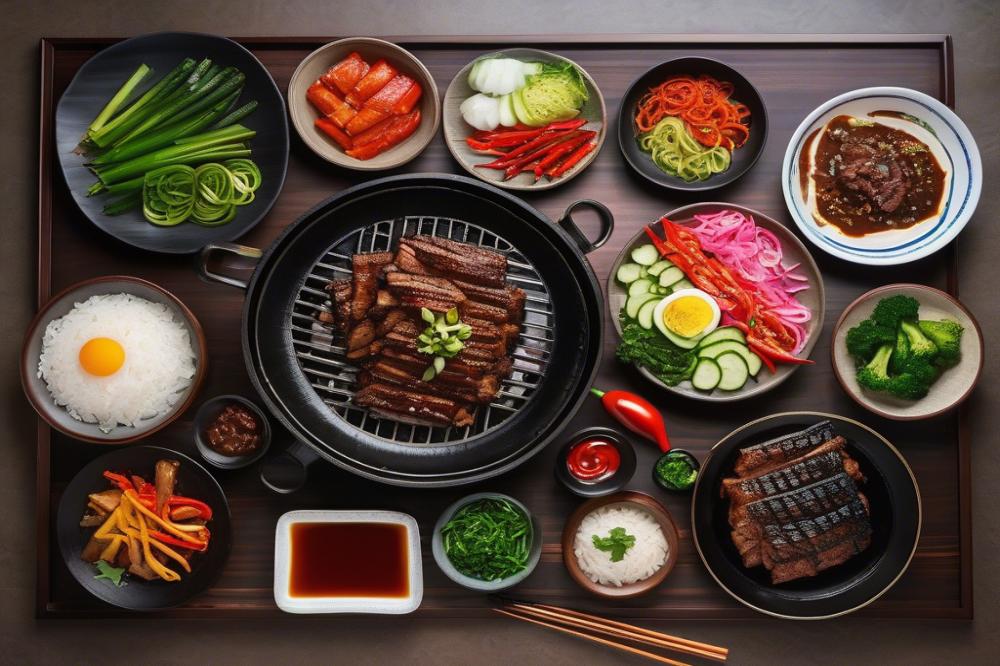
Yangnyeom Galbi features tender marinated ribs that capture the heart of Korean barbecue. This dish stands out among various grilled meat options due to its rich, flavorful marinade. Made primarily with beef ribs, it combines the right balance of sweet and savory flavors.
The marinade typically includes soy sauce, sesame oil, and garlic. These ingredients work together to create a taste that is both delicious and memorable. Each ingredient adds its own character, enhancing the overall experience of the dish.
Traditional recipes for Yangnyeom Galbi often vary, showcasing different regional styles. Some may include additional elements like pear or honey, which contribute to the marinade’s sweetness. Techniques for cooking involve grilling over high heat, ensuring that the ribs develop a perfect char while remaining juicy on the inside.
This dish holds significant cultural importance during Korean meals and gatherings. Families and friends often gather around the grill, sharing stories and laughter while cooking together. The act of grilling becomes a shared experience, creating lasting memories and connections.
Celebrations frequently feature Yangnyeom Galbi as a highlight. Its irresistible aroma and appearance draw everyone in. When served, the fragrant ribs become the centerpiece of the meal, encouraging people to fully engage with one another.
Overall, marinated ribs like Yangnyeom Galbi not only satisfy the palate but also nourish relationships. Each bite connects individuals to Korean cuisine‘s rich heritage. Understanding its essence is crucial for anyone wanting to appreciate authentic Korean BBQ.
Ingredients and Nutritional Information
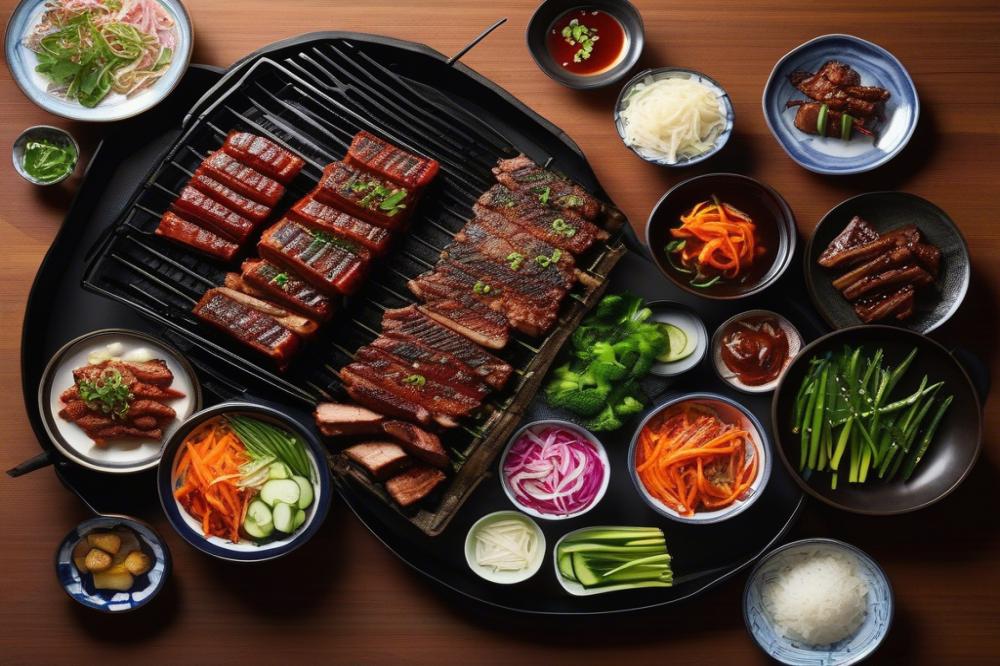
The heart of authentic Korean cuisine lies in its rich flavors and quality ingredients. For this delicious recipe, you will need the following:
- 2 lbs beef ribs (flanken cut)
- 1/2 cup soy sauce
- 1/2 cup brown sugar
- 1/4 cup sesame oil
- 4 cloves garlic (minced)
- 1/2 cup green onions (chopped)
- 2 tablespoons grated ginger
- 1 tablespoon black pepper
- 1 tablespoon sesame seeds
- 1 tablespoon rice wine (optional)
These marinated ribs balance sweet and savory flavors perfectly. Beef ribs provide a rich base, allowing the marinade to enhance their natural taste. Soy sauce adds a salty umami kick, while brown sugar gives a subtle sweetness. Sesame oil contributes a toasted nutty aroma, and garlic offers a pungent depth that complements grilled meat remarkably well.
Green onions freshen the dish, adding a mild bite. Grated ginger brings a zesty note, which brightens the overall flavor profile. Black pepper gives spice without overwhelming the palate, while sesame seeds introduce a delightful crunch. The optional rice wine can deepen the flavor further, but it is not necessary for an authentic taste.
Nutritional Information
For those who track their nutrition, here is a breakdown of the essential values per serving:
- Calories: 450
- Protein: 30g
- Fats: 28g
- Carbohydrates: 23g
- Sugars: 15g
Each ingredient contributes to this nutritional profile in various ways. Beef ribs are an excellent source of protein and healthy fats, crucial for muscle growth and energy. They contain iron, which is essential for blood health. Soy sauce, while high in sodium, offers flavor without adding excessive calories. Brown sugar is a source of quick energy, though it should be consumed in moderation. Garlic has health benefits, including antibacterial properties and potential heart health improvements. Finally, sesame oil is rich in unsaturated fats, which can promote heart health.
Understanding these elements can elevate not just the cooking experience but also the dining pleasure. Enjoy crafting your dish with these insights in mind.
Preparation and Cooking Techniques
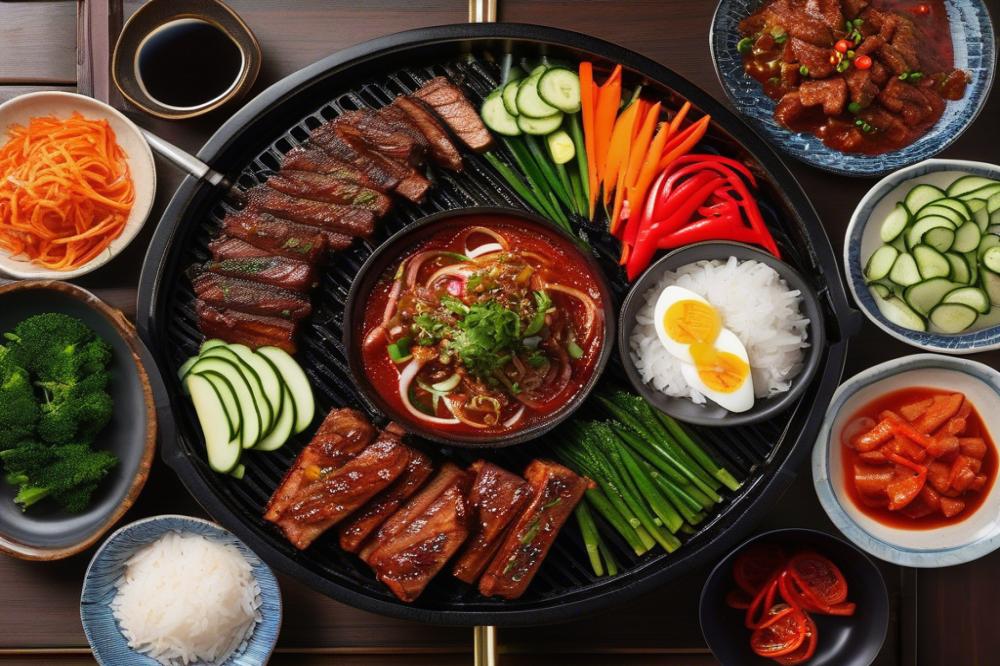
Marinating the beef ribs is an essential step in creating delicious yangnyeom galbi. Start by gathering your ingredients. For a classic marinade, you will need soy sauce, garlic, sesame oil, sugar, and ground black pepper. Combining these ingredients creates a unique balance of sweet and savory flavors that define Korean cuisine.
Next, slice your beef ribs in a way that allows the marinade to penetrate. This cut is often referred to as flanken-style, which enables better absorption of the marinade. Once the ribs have been cut, place them in a large mixing bowl.
Pour the marinade over the beef ribs, ensuring they are fully coated. For the best results, let the ribs marinate for at least four hours, but overnight is preferred for maximum flavor. During this time, the garlic and sesame oil will infuse the meat.
Techniques for Grilling
Grilling is the next step, which brings out the flavors of the marinated ribs. Preheat your grill to a medium-high temperature. A hot grill is crucial for achieving that perfect char. Place the marinated meat on the grill, following the natural shape of the ribs. Avoid overcrowding the grill to allow for even cooking.
Flipping the ribs every few minutes will help ensure they cook evenly. Use tongs instead of a fork to avoid piercing the meat. This will keep the juices locked in. The goal is to achieve a nice caramelized exterior while keeping the inside tender.
Acharred crust can develop in ten to fifteen minutes of grilling. Monitor the ribs closely to prevent them from drying out. If they start to become too charred, move them to a cooler part of the grill to slow down cooking. This technique allows for better control over doneness and moisture retention.
Keep a close eye on the grill during cooking. Baste the ribs with leftover marinade for added flavor and moisture. However, do not use the marinade from raw meat after it’s been on the grill.
Serving Suggestions and Accompaniments
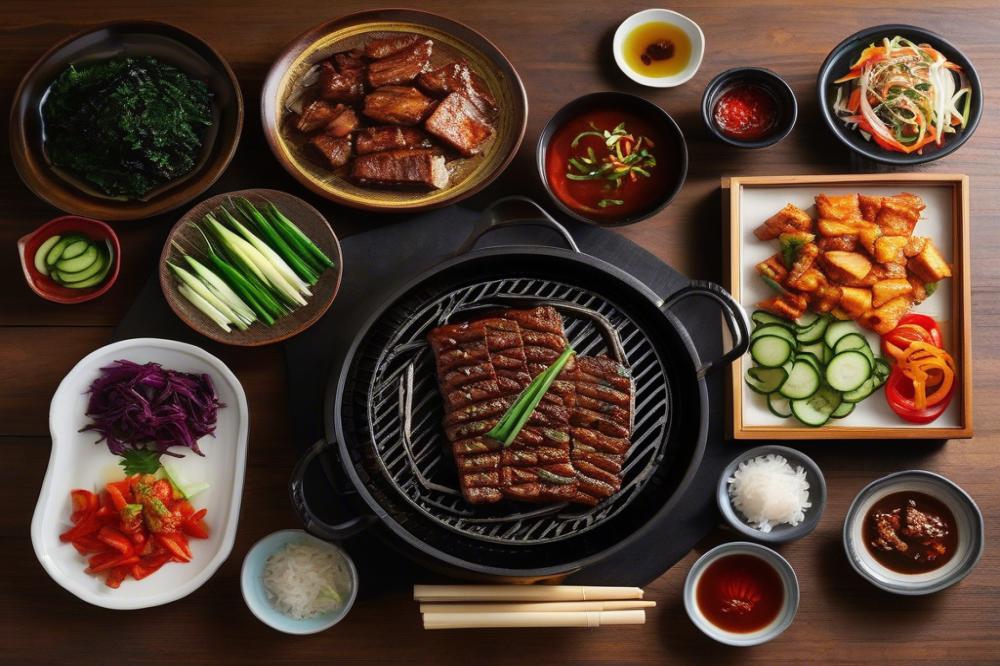
When it comes to enjoying marinated ribs, traditional sides play a crucial role in enhancing the meal’s overall experience. Kimchi is a must-have. This fermented dish offers a spicy kick that pairs wonderfully with the sweet and savory flavors of the grilled meat. Different varieties exist, with Napa cabbage and radish being the most popular. They add a crunchy texture and a burst of flavor that cuts through the richness of the beef.
Rice is another essential component of Korean cuisine. Serving sticky white rice alongside helps balance the intense flavors. Guests often scoop a bit of rice, followed by the smoky meat, into lettuce leaves or wraps. This combination is both satisfying and delicious. It’s a simple yet effective way to enjoy the dish while adding freshness.
Pickled vegetables also make great accompaniments. These can range from pickled cucumbers to slices of radish. Their tangy taste complements the marinated ribs beautifully. The sharpness of the pickles contrasts with the rich flavors of the beef and adds another layer to the meal.
For gatherings, presentation is key. Arrange the grilled meat on a large platter, showcasing the beautifully caramelized surface. Surround it with small bowls of the traditional side dishes. Brightly colored vegetables and kimchi will draw everyone’s attention. Consider adding dipping sauces, such as gochujang or a sesame oil mix, to enhance the flavors even further.
In Korea, the culture around sharing meals is significant. Family and friends often gather around the grill, taking turns to cook the meat to perfection. This communal aspect of enjoying food adds to the overall enjoyment. A relaxed atmosphere encourages conversation and connection among diners. Cooking techniques used, like grilling over charcoal, elevate the flavors and aroma, making the experience memorable.
Sharing plates and sides fosters a sense of togetherness. In many homes, the table becomes a lively spot filled with laughter and chatter. Guests will often share stories while enjoying their meal, making the experience not just about the food, but also the bonds that form around it.
Variations and Personal Touches
Different cooks have their own ways to make marinated ribs taste incredible. Traditional recipes focus on a mix of soy sauce, garlic, sesame oil, and sugar. A switch in elements can create fresh flavor twists. For example, adding gochujang, the spicy red pepper paste, can introduce heat. It’s a favorite change for many who enjoy a kick to their grilled meat. If experimenting with sweetness, honey or brown sugar could enhance the sweet and savory balance.
Using other types of meat offers new experiences. Lamb or pork chops can hold the marinade quite well, bringing richness to the dish. Though beef ribs are a staple, these alternatives provide an exciting twist without losing the essence of the original. Adjusting marination times can also change the outcome. A longer soak for pork might be better than for beef.
Regional variations within Korean cuisine are fascinating, too. In Jeolla Province, for instance, some add fruits like pears or apples to the marinade for a natural sweetness. This is a clever trick to tenderize the meat further. Nearby regions might use different spices or cooking techniques, reflecting local tastes. Each region showcases its flair through subtle changes in ingredients, creating delightful diversity in flavors.
Think about side dishes as well when planning your meal. Certain locations feature unique banchan, or side dishes, that pair well with their version of galbi. Whether serving kimchi or pickled vegetables, these add depth and contrast to the meal. The experience of enjoying the dish enriched by these sides makes each meal memorable.
Closing Thoughts on Authentic Korean Cuisine
Authenticity holds great significance in Korean cooking. Traditional recipes carry the stories and customs passed down through generations. Each dish is a reflection of the culture, making every meal an experience worth savoring. When it comes to preparing marinated ribs, sticking to authentic methods can truly enhance flavors and textures. The balance of sweet and savory in a well-crafted Yangnyeom Galbi marinade is a testament to this truth.
Trying your hand at these delightful flavors at home can be quite rewarding. Imagine gathering ingredients and mixing them together, just like families do in Korea. Embracing this culinary adventure allows you to explore new tastes while connecting with a rich culture. Moreover, grilling your creation just adds to the excitement. The aromas that fill the air while cooking can make any occasion feel special.
Sharing food with loved ones is a beautiful experience. It invites laughter, conversation, and the creation of memories around the table. Each bite of your homemade dish can spark stories and joy. So, gather your family or friends, and dive into the process of making your own version of these flavorful ribs. With every bite, celebrate the essence of Korean cuisine and the warmth of shared moments.

